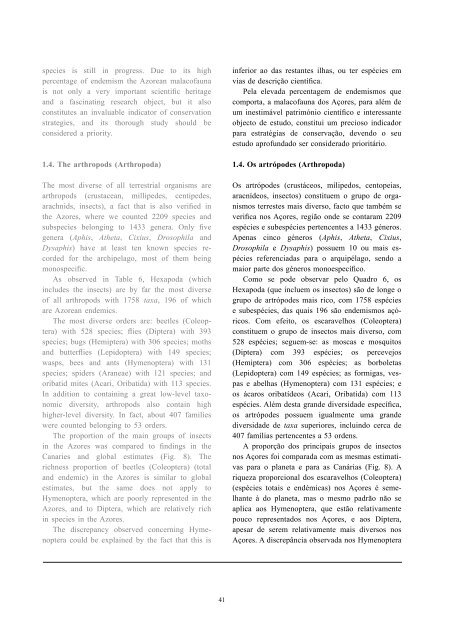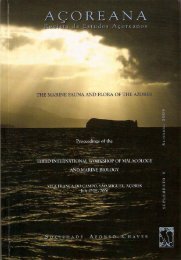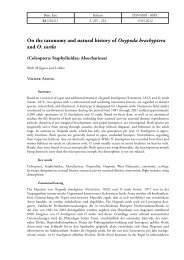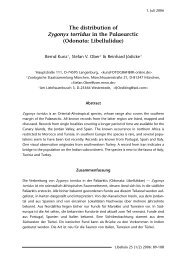(eds.) (2005). - Portal da Biodiversidade dos Açores - Universidade ...
(eds.) (2005). - Portal da Biodiversidade dos Açores - Universidade ...
(eds.) (2005). - Portal da Biodiversidade dos Açores - Universidade ...
Create successful ePaper yourself
Turn your PDF publications into a flip-book with our unique Google optimized e-Paper software.
species is still in progress. Due to its high<br />
percentage of endemism the Azorean malacofauna<br />
is not only a very important scientific heritage<br />
and a fascinating research object, but it also<br />
constitutes an invaluable indicator of conservation<br />
strategies, and its thorough study should be<br />
considered a priority.<br />
1.4. The arthropods (Arthropo<strong>da</strong>)<br />
The most diverse of all terrestrial organisms are<br />
arthropods (crustacean, millipedes, centipedes,<br />
arachnids, insects), a fact that is also verified in<br />
the Azores, where we counted 2209 species and<br />
subspecies belonging to 1433 genera. Only five<br />
genera (Aphis, Atheta, Cixius, Drosophila and<br />
Dysaphis) have at least ten known species recorded<br />
for the archipelago, most of them being<br />
monospecific.<br />
As observed in Table 6, Hexapo<strong>da</strong> (which<br />
includes the insects) are by far the most diverse<br />
of all arthropods with 1758 taxa, 196 of which<br />
are Azorean endemics.<br />
The most diverse orders are: beetles (Coleoptera)<br />
with 528 species; flies (Diptera) with 393<br />
species; bugs (Hemiptera) with 306 species; moths<br />
and butterflies (Lepidoptera) with 149 species;<br />
wasps, bees and ants (Hymenoptera) with 131<br />
species; spiders (Araneae) with 121 species; and<br />
oribatid mites (Acari, Oribati<strong>da</strong>) with 113 species.<br />
In addition to containing a great low-level taxonomic<br />
diversity, arthropods also contain high<br />
higher-level diversity. In fact, about 407 families<br />
were counted belonging to 53 orders.<br />
The proportion of the main groups of insects<br />
in the Azores was compared to findings in the<br />
Canaries and global estimates (Fig. 8). The<br />
richness proportion of beetles (Coleoptera) (total<br />
and endemic) in the Azores is similar to global<br />
estimates, but the same does not apply to<br />
Hymenoptera, which are poorly represented in the<br />
Azores, and to Diptera, which are relatively rich<br />
in species in the Azores.<br />
The discrepancy observed concerning Hymenoptera<br />
could be explained by the fact that this is<br />
41<br />
inferior ao <strong>da</strong>s restantes ilhas, ou ter espécies em<br />
vias de descrição científica.<br />
Pela eleva<strong>da</strong> percentagem de endemismos que<br />
comporta, a malacofauna <strong>dos</strong> <strong>Açores</strong>, para além de<br />
um inestimável património científico e interessante<br />
objecto de estudo, constitui um precioso indicador<br />
para estratégias de conservação, devendo o seu<br />
estudo aprofun<strong>da</strong>do ser considerado prioritário.<br />
1.4. Os artrópodes (Arthropo<strong>da</strong>)<br />
Os artrópodes (crustáceos, mílipe<strong>dos</strong>, centopeias,<br />
aracnídeos, insectos) constituem o grupo de organismos<br />
terrestes mais diverso, facto que também se<br />
verifica nos <strong>Açores</strong>, região onde se contaram 2209<br />
espécies e subespécies pertencentes a 1433 géneros.<br />
Apenas cinco géneros (Aphis, Atheta, Cixius,<br />
Drosophila e Dysaphis) possuem 10 ou mais espécies<br />
referencia<strong>da</strong>s para o arquipélago, sendo a<br />
maior parte <strong>dos</strong> géneros monoespecífico.<br />
Como se pode observar pelo Quadro 6, os<br />
Hexapo<strong>da</strong> (que incluem os insectos) são de longe o<br />
grupo de artrópodes mais rico, com 1758 espécies<br />
e subespécies, <strong>da</strong>s quais 196 são endemismos açóricos.<br />
Com efeito, os escaravelhos (Coleoptera)<br />
constituem o grupo de insectos mais diverso, com<br />
528 espécies; seguem-se: as moscas e mosquitos<br />
(Diptera) com 393 espécies; os percevejos<br />
(Hemiptera) com 306 espécies; as borboletas<br />
(Lepidoptera) com 149 espécies; as formigas, vespas<br />
e abelhas (Hymenoptera) com 131 espécies; e<br />
os ácaros oribatídeos (Acari, Oribati<strong>da</strong>) com 113<br />
espécies. Além desta grande diversi<strong>da</strong>de específica,<br />
os artrópodes possuem igualmente uma grande<br />
diversi<strong>da</strong>de de taxa superiores, incluindo cerca de<br />
407 famílias pertencentes a 53 ordens.<br />
A proporção <strong>dos</strong> principais grupos de insectos<br />
nos <strong>Açores</strong> foi compara<strong>da</strong> com as mesmas estimativas<br />
para o planeta e para as Canárias (Fig. 8). A<br />
riqueza proporcional <strong>dos</strong> escaravelhos (Coleoptera)<br />
(espécies totais e endémicas) nos <strong>Açores</strong> é semelhante<br />
à do planeta, mas o mesmo padrão não se<br />
aplica aos Hymenoptera, que estão relativamente<br />
pouco representa<strong>dos</strong> nos <strong>Açores</strong>, e aos Díptera,<br />
apesar de serem relativamente mais diversos nos<br />
<strong>Açores</strong>. A discrepância observa<strong>da</strong> nos Hymenoptera

















